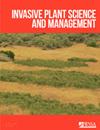草地上对传粉者友好的植物群:一个案例研究
IF 1.2
4区 生物学
Q3 PLANT SCIENCES
引用次数: 2
摘要
摘要入侵的冬季一年生草本植物,如三叶草(Bromus tectorum L.),被认为是对区域生物多样性的严重威胁。依赖本地植物群的传粉昆虫种群可能会受到负面影响,因为这些本地物种可能会被入侵的草种取代。据预测,在美国西部已经干旱的地区,由于死亡的植物部分提供了燃料,作弊草的定居也会增加野火的风险。生物防治、放牧、规定的焚烧或使用广谱非选择性除草剂已被认为是控制B.tectorum的可能手段。有效的控制可以促进本地植物群的再生,进而支持其他生态系统功能。作为一个案例研究,我们报告了我们的发现,我们在这里描述了一种预效除草剂吲唑福明的应用结果,该除草剂限制了B.tectorum种子的发芽。除草剂在2016年12月、2017年1月和2017年2月期间应用于研究地点。这里报告的开花植物多样性数据是在2018年5月至9月期间收集的。与未经处理的对照相比,除草剂处理的地块在实施香茅控制后的两个季节内开花植物的多样性和丰度都有所增加,这表明有效减少入侵一年生香茅的数量可能有助于促进本地杂草的生长。有必要进行进一步的研究,以了解促进本地开花物种重建的机制,减少入侵一年生草本植物的长期后果,并记录除草剂对地面筑巢传粉昆虫的任何残留影响。本文章由计算机程序翻译,如有差异,请以英文原文为准。
Pollinator-friendly flora in rangelands following control of cheatgrass (Bromus tectorum): a case study
Abstract Invasive winter annual grasses, such as cheatgrass (Bromus tectorum L.) are considered serious threats to regional biodiversity. Pollinator populations that depend on the native flora are likely to be negatively impacted as these native species may be displaced by the invasive grass species. Colonization by cheatgrass is also predicted to increase risk of wildfires, as dead plant parts provide fuel in the already dry and arid regions of the western United States. Biocontrol, grazing, prescribed burning, or use of broad-spectrum nonselective herbicides have been suggested as possible means to control B. tectorum. Efficient control may facilitate regrowth of native flora that could in turn support other ecosystem functions. Reporting our findings as a case study, we describe here the results of the application of a preemergent herbicide, indaziflam, that limits germination of B. tectorum seeds. Herbicide was applied to the study locations during the months of December 2016, January 2017, and February 2017. The data reported here on the diversity of flowering plants were collected between May through September 2018. Herbicide-treated plots showed an increase in diversity and abundance of flowering plants compared to the untreated control within two seasons after cheatgrass control was implemented, suggesting that effective reduction of the population of the invasive annual cheatgrass may help facilitate the growth of native forbs. Further studies are necessary to understand mechanisms that facilitate reestablishment of native flowering species, the long-term consequences of reducing invasive annual grasses and to document any residual effects of the herbicide on ground-nesting pollinators.
求助全文
通过发布文献求助,成功后即可免费获取论文全文。
去求助
来源期刊

Invasive Plant Science and Management
PLANT SCIENCES-
CiteScore
2.20
自引率
9.10%
发文量
24
审稿时长
6-12 weeks
期刊介绍:
Invasive Plant Science and Management (IPSM) is an online peer-reviewed journal focusing on fundamental and applied research on invasive plant biology, ecology, management, and restoration of invaded non-crop areas, and on other aspects relevant to invasive species, including educational activities and policy issues. Topics include the biology and ecology of invasive plants in rangeland, prairie, pasture, wildland, forestry, riparian, wetland, aquatic, recreational, rights-of-ways, and other non-crop (parks, preserves, natural areas) settings; genetics of invasive plants; social, ecological, and economic impacts of invasive plants and their management; design, efficacy, and integration of control tools; land restoration and rehabilitation; effects of management on soil, air, water, and wildlife; education, extension, and outreach methods and resources; technology and product reports; mapping and remote sensing, inventory and monitoring; technology transfer tools; case study reports; and regulatory issues.
 求助内容:
求助内容: 应助结果提醒方式:
应助结果提醒方式:


